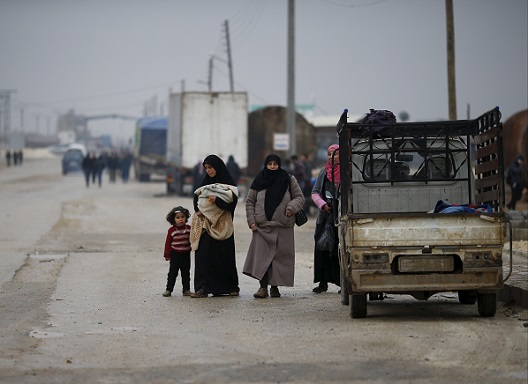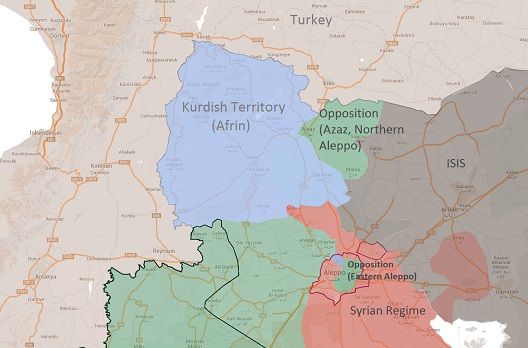 Aleppo and Azaz are two cities in northern Syria that represent the result of US Syria policy. After five years of half measures, false starts, broken red lines, and bouts of funding for Syrian aid and development projects, we have now entered a new phase: uncoordinated pieces of the US intelligence and defense community supporting opposing Syrian actors who are now engaged in a bitter armed struggle for control of northwestern Aleppo province and Aleppo city.
Aleppo and Azaz are two cities in northern Syria that represent the result of US Syria policy. After five years of half measures, false starts, broken red lines, and bouts of funding for Syrian aid and development projects, we have now entered a new phase: uncoordinated pieces of the US intelligence and defense community supporting opposing Syrian actors who are now engaged in a bitter armed struggle for control of northwestern Aleppo province and Aleppo city.
The US Department of Defense (DoD) supported Syrian Democratic Forces (SDF), which is composed mainly of Kurdish People’s Protection Units (YPG), are actively engaging CIA-supported intelligence forces around Azaz. Kurdish forces want to unite their western canton, Afrin, with their other cantons in northern Syria, Kobane and Jazira. Turkey and Saudi Arabia have both indicated that they are willing to send troops into Syria, and Turkey has closed the border crossing near Azaz and begun building camps for internally displaced persons inside of Syria, a move many analysts believe is meant to put pressure on the international community to support the establishment of Turkey’s proposed safe zones. All of this is happening amidst Russia’s massive air campaign to reshape the military map of Syria in favor of the Assad regime.
The current clash between the CIA and the DoD is not a result of either institution failing to carry out its orders or adroitly institute the policy parameters that the White House provided. The fault for this policy lies at the feet of the Obama administration, which has pinned its hopes on the Assad regime and its Iranian and Russian backers adhering to the UN resolutions and “recogniz[ing] the truths” that Obama has shared with them—that the Syrian civil war cannot end with Assad in power. While waiting for them to come to their senses, the White House is trying to fight two proxy wars. The DoD is supporting the SDF to fight the Islamic State (ISIS) in eastern Syria, while the CIA is supporting the opposition in western Syria against the Assad regime.
It is clear, though, that these programs are contradictory and detrimental to US interests in the Middle East and deadly for the Syrian people. The Kurds are focused on uniting their territories and gaining autonomy, and are reluctant to fight ISIS outside of these territories. Local and international human rights organizations have documented how the YPG has displaced Arabs to unite its territories. These tactics have alienated and angered Syrian Arabs and made them reluctant to work with the SDF.
The failure of these contradictory policies has come to head in eastern Aleppo city and Azaz, an opposition held city in northern Aleppo near the Turkish border. Azaz and its surrounding environs, a mere 3.5 by 5 miles, is now hosting 200,000 IDPs. The Syrian armed opposition, which the CIA supports with weapons and training, is fighting on three fronts: against the DoD-backed SDF in the west, against the Assad regime in the south, and against ISIS in the east.
With these three opposing forces hemming them in, people began fleeing to Turkey, only to have Turkey close the border and instead build camps for the Syrians in northern Aleppo. Turkey sees the safe zone as a buffer to prevent the Kurds from uniting their three cantons, Afrin, Kobani, and Jazira, but is unwilling to send in ground troops without more international support. The YPG has direct links to the Kurdistan Workers’ Party (PKK), a US and Turkish designated terror group. Turkey and Saudi Arabia have both indicated that they are willing to send ground forces into Syria, but want support from the international coalition, especially because they are afraid of finding themselves in direct confrontation with Russia.

The US support of the YPG is hurting its relations with Turkey, which says that the PKK poses more of a threat to its security than ISIS. Further aggravating US-Turkish relations is that the US “appears to be quietly encouraging the Kurds to grab more territory, even at the expense of moderate rebels it has aided and trained, to ensure that Assad’s Russian-backed forces don’t get there first.” The United State’s balancing act between supporting the YPG while denying their connections to the PKK will continue to have negative consequences for US relations in the region. Syria’s Kurds want diplomatic recognition, and Russia has hinted that it will support the Kurds’ efforts to gain autonomy, but the United States cannot do the same if it wants to maintain relations with Turkey.
Turkey, Saudi Arabia, and the cornered opposition groups have found their options limited, and decided to form a new coalition, called Jaysh Halab, which includes many US-supported armed units. Although the group says that it will fight the regime and ISIS, it also says that it will attack the YPG and Jaish al-Thuwwar. Its first operations were reportedly against the latter two.
Opposition-held Azaz has become a semi-besieged area. Russian airstrikes continue unabated and the Médecins Sans Frontières and Amnesty International have already concluded that the Russian air force is specifically targeting civilian infrastructure in a scorched earth, group punishment tactic designed to completely destroy any capacity for rebel held areas like Azaz to sustain themselves without external support. Already UNOCHA supported partners have mobilized to provide much needed emergency aid to Azaz, with reported 5,680 households being provided ready-to-eat-rations, bread, or cooked meals. The scope of need within Azaz is still being assessed because every day more IDPs arrive or require emergency aid.
Eastern Aleppo city has been under threat of being besieged for the better part of two years, but recent regime advances with Russian air support have made that threat more imminent. Estimates are that some 300,000 people still live in eastern Aleppo city and are now trapped there. With the Russian airstrikes rolling back rebel territory across northern Aleppo countryside, the main humanitarian access points to Aleppo city have all but closed. One major neighborhood that could potentially serve as a bridge between rebel-held Aleppo countryside and eastern Aleppo city is Sheikh Maqsoud, but it is under the control of the Kurdish YPG.
In both the case of Azaz and eastern Aleppo city, the Kurdish YPG are the spoilers who are helping create the conditions for large scale sieges to occur. To be clear, the majority of the blame for these two new besieged areas lays at the feet of the Assad Regime and its Russian ally, who have decided that they can indiscriminately target civilians to crush any opposition. But there can be no denial that the Obama administration’s contradictory Syria policy—through its support of the Kurdish YPG on one side and the armed opposition on the other—is aiding and abetting the catastrophic scenario currently playing out in Aleppo and Azaz, worsening US-relations with its regional allies, letting the regime and Russia have free reign in Syria, and alienating the opposition and any grassroots support the United States may have had.
Sasha Ghosh-Siminoff is the president and co-founder of People Demand Change, a development organization that provides aid and support to civil society actors in the Middle East. He was previously the executive director of Syrian Emergency Task Force. The views expressed in the article are the author’s and do not represent those of the People Demand Change.
Image: Photo: An internally displaced Syrian woman carries a baby as she and others walk near the Bab al-Salam crossing, across from Turkey's Kilis province, on the outskirts of the northern border town of Azaz, Syria February 6, 2016. REUTERS/Osman Orsal
